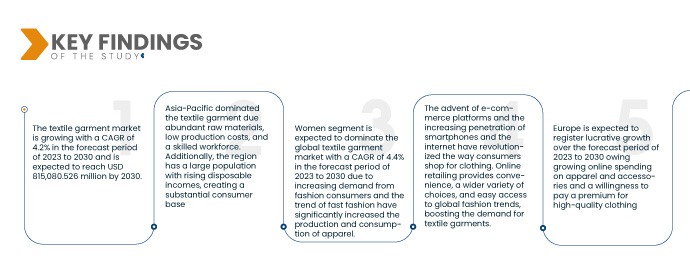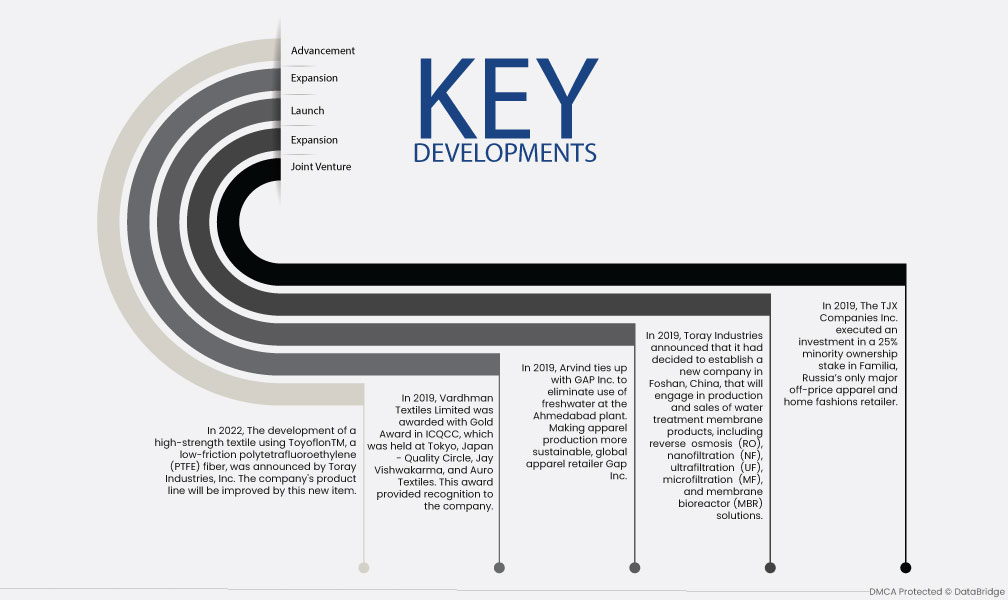The design, manufacture, and distribution of yarn, cloth, clothing, and garments are all aspects of the textile market. Natural or synthetic raw materials, which might be made with the aid of chemical industry products, are both possible. The national economies of many nations are significantly influenced by the textile and apparel industries. The market for textile garments is being driven forward by young people's increasing awareness of the most recent fashion trends. The market for textile garments is growing as a result of rising online apparel and accessory spending, rising willingness to pay more for high-quality clothing, raising awareness of sustainable and eco-friendly clothing, and more.
Access full Report @ https://www.databridgemarketresearch.com/reports/global-textile-garment-market
Data Bridge Market Research analyses that the Textile Garment Market is growing with a CAGR of 4.2% in the forecast period of 2023 to 2030 and is expected to reach USD 815,080.526 million by 2030. The rise of e-commerce platforms and digital transformation has disrupted the textile garment market. Online retail channels provide consumers with convenience, wider product selections, and easy access to global brands. E-commerce also enables direct-to-consumer business models, allowing brands to establish their online presence and reach a broader customer base.
Key Findings of the Study
Growing disposable income is expected to drive the market's growth rate
As economies experience growth and individuals' disposable incomes increase, consumers have more financial resources available for non-essential purchases, including clothing. This rising affordability plays a significant role in driving the demand for textile garments, particularly in emerging markets. As people have more purchasing power, they are able to invest in a wider variety of clothing options, fueling the growth of the textile garment market in these regions.
Report Scope and Market Segmentation
|
Report Metric
|
Details
|
|
Forecast Period
|
2023 to 2030
|
|
Base Year
|
2022
|
|
Historic Years
|
2021 (Customizable to 2015-2020)
|
|
Quantitative Units
|
Revenue in USD Million, Volumes in Units, Pricing in USD
|
|
Segments Covered
|
Material Type (Cotton, Denim, Wool, Silk, and Others), Product (Women, Men, and Kids).
|
|
Countries Covered
|
U.S., Canada and Mexico in North America, Germany, France, U.K., Netherlands, Switzerland, Belgium, Russia, Italy, Spain, Turkey, Rest of Europe in Europe, China, Japan, India, South Korea, Singapore, Malaysia, Australia, Thailand, Indonesia, Philippines, Rest of Asia-Pacific (APAC) in the Asia-Pacific (APAC), Saudi Arabia, U.A.E, South Africa, Egypt, Israel, Rest of Middle East and Africa (MEA) as a part of Middle East and Africa (MEA), Brazil, Argentina and Rest of South America as part of South America
|
|
Market Players Covered
|
TORAY INDUSTRIES, INC. (Japan), Arvind Limited (India), Grasim Industries Limited (India), YOUNGOR (China), PVH Corp (U.S.)Tabb Textile Company Inc. (Canada), Ruby Mills (India), Alok Industries Ltd (India), DIOR (France), KPR MILL LIMITED (India), HYOSUNG TNC (South Korea), Texhong Textile Group Limited (China), Apparel Production (India), The TJX Companies, Inc (U.S.), Vardhman Textiles Limited (India) among others
|
|
Data Points Covered in the Report
|
In addition to the market insights such as market value, growth rate, market segments, geographical coverage, market players, and market scenario, the market report curated by the Data Bridge Market Research team includes in-depth expert analysis, import/export analysis, pricing analysis, production consumption analysis, and consumer behavior.
|
Segment Analysis:
The textile garment market is segmented on the basis of type, and product.
- On the basis of material type, the global textile garment market is segmented into cotton, denim, wool, silk and others. In 2023, the cotton segment is expected to dominate the global textile garment market with a CAGR of 4.5% in the forecast period of 2023 to 2030 due to the shifting preference towards natural fiber based textile garments. Cotton has superior property such as high strength, absorption, and color retention, which is increasing its demand in the market.
In 2023, cotton segment is expected to dominate the material type of the global textile garment market
In 2023, the cotton segment is expected to dominate the global textile garment market owing to the fluctuating preference towards natural fiber-based textile garments. Cotton has superior property such as high strength, immersion, and color preservation, which is growing its demand in the market with a CAGR of 4.5% in the forecast period of 2023 to 2030
- On the basis of product, the global textile garment market is segmented into women, men and kids. In 2023, women segment is expected to dominate the global textile garment market with a CAGR of 4.4% in the forecast period of 2023 to 2030 due to a wide range of items, such as clothing, footwear, accessories, cosmetics, personal care products, and healthcare products tailored to women's needs. Women's products often consider factors like fashion trends, style preferences, comfort, and specific health and wellness requirements.
Major Players
Data Bridge Market Research recognizes the following companies as the major textile garment market players in textile garment market are TORAY INDUSTRIES, INC. (Japan), Arvind Limited (India), Grasim Industries Limited (India), YOUNGOR (China), PVH Corp (U.S.)Tabb Textile Company Inc. (Canada), Ruby Mills (India), Alok Industries Ltd (India), DIOR (France), KPR MILL LIMITED (India),
Market Development
- In 2022, The development of a high-strength textile using ToyoflonTM, a low-friction polytetrafluoroethylene (PTFE) fiber, was announced by Toray Industries, Inc. The company's product line will be improved by this new item.
- In 2019, Vardhman Textiles Limited was awarded with Gold Award in ICQCC, which was held at Tokyo, Japan - Quality Circle, Jay Vishwakarma, and Auro Textiles. This award provided recognition to the company.
- In 2019, Arvind ties up with GAP Inc. to eliminate use of freshwater at the Ahmedabad plant. Making apparel production more sustainable, global apparel retailer Gap Inc.
- In 2019, Toray Industries announced that it had decided to establish a new company in Foshan, China, that will engage in production and sales of water treatment membrane products, including reverse osmosis (RO), nanofiltration (NF), ultrafiltration (UF), microfiltration (MF), and membrane bioreactor (MBR) solutions.
- In 2019, The TJX Companies Inc. executed an investment in a 25% minority ownership stake in Familia, Russia’s only major off-price apparel and home fashions retailer.
Regional Analysis
Geographically, the countries covered in the textile garment market report are U.S., Canada and Mexico in North America, Germany, France, U.K., Netherlands, Switzerland, Belgium, Russia, Italy, Spain, Turkey, Rest of Europe in Europe, China, Japan, India, South Korea, Singapore, Malaysia, Australia, Thailand, Indonesia, Philippines, Rest of Asia-Pacific (APAC) in the Asia-Pacific (APAC), Saudi Arabia, U.A.E, South Africa, Egypt, Israel, Rest of Middle East and Africa (MEA) as a part of Middle East and Africa (MEA), Brazil, Argentina and Rest of South America as part of South America
As per Data Bridge Market Research analysis:
Asia-Pacific is the dominant region in the textile garment market during the forecast period 2023-2030
The Asia-Pacific region is dominating the global textile garment market due to several factors. It is home to major textile manufacturing countries such as China, India, Bangladesh, and Vietnam, which have abundant raw materials, low production costs, and a skilled workforce. Additionally, the region has a large population with rising disposable incomes, creating a substantial consumer base. The strong presence of manufacturing facilities, competitive pricing, and export capabilities contribute to Asia-Pacific's dominance in the global textile garment market.
Europe is estimated to be the fastest-growing region in the textile garment market in the forecast period 2023-2030
Germany is projected to dominate the textile garment market in Europe, fueled by growing online spending on apparel and accessories and a willingness to pay a premium for high-quality clothing. The U.A.E has emerged as a leader in the textile garment market in the Middle East and Africa due to the rising demand for sustainable clothing. Consumers in the region prioritize environmentally-friendly fashion, driving the market's focus towards sustainable and ethically produced garments.
For more detailed information about the textile garment market report, click here – https://www.databridgemarketresearch.com/reports/global-textile-garment-market












